 Prof. Rodger A. Randle
Prof. Rodger A. Randle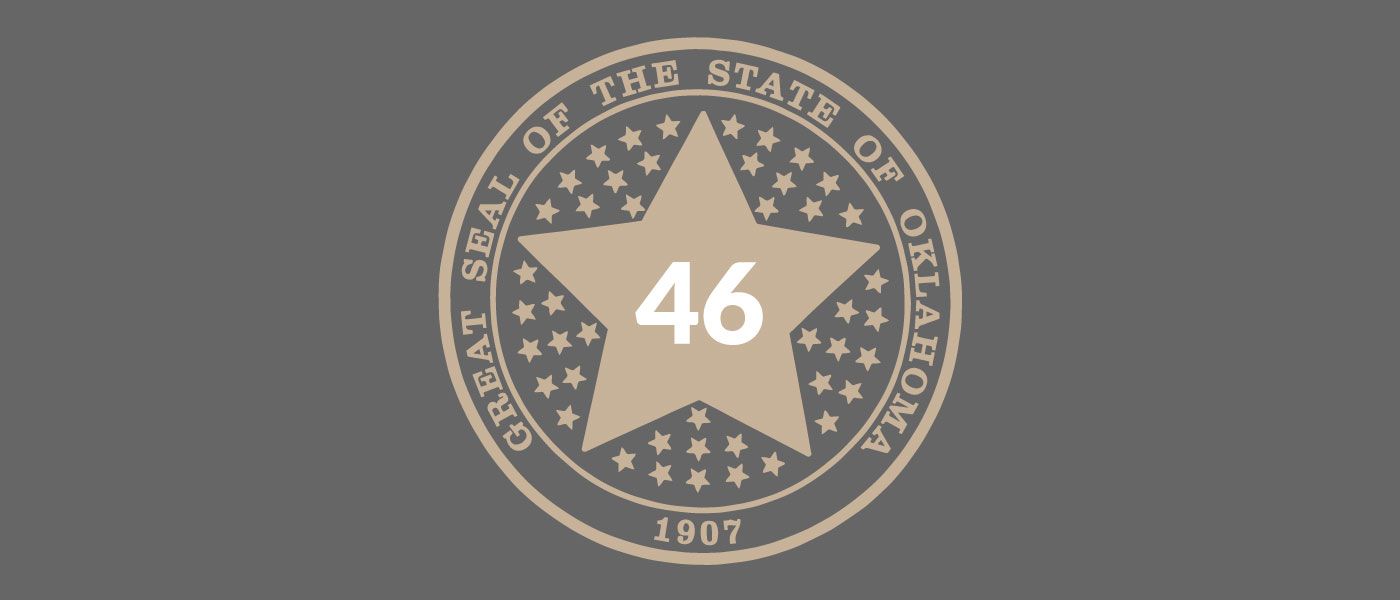
that was added to the American flag when Oklahoma was admitted to the Union.
Evolution of Oklahoma Politics
politics of the people who settled here.
Oklahoma was born in politics.
The state of Oklahoma was formed by combining two territories, Oklahoma Territory and Indian Territory, to create a new state. Never before in American history had a territory not entered the Union as an independent state. It was originally anticipated that Indian Territory would become the State of Sequoyah and Oklahoma Territory would become the State of Oklahoma. However, politics intervened. The national administration, Republican at the time, feared the creation of two new states that would both likely elect two Democrat senators each. President Theodore Roosevelt brokered a compromise that would combine the two territories into a single state, thus sending only two new (Democrat) senators to Washington, and thus making less of an impact on the balance of power at the Capitol.
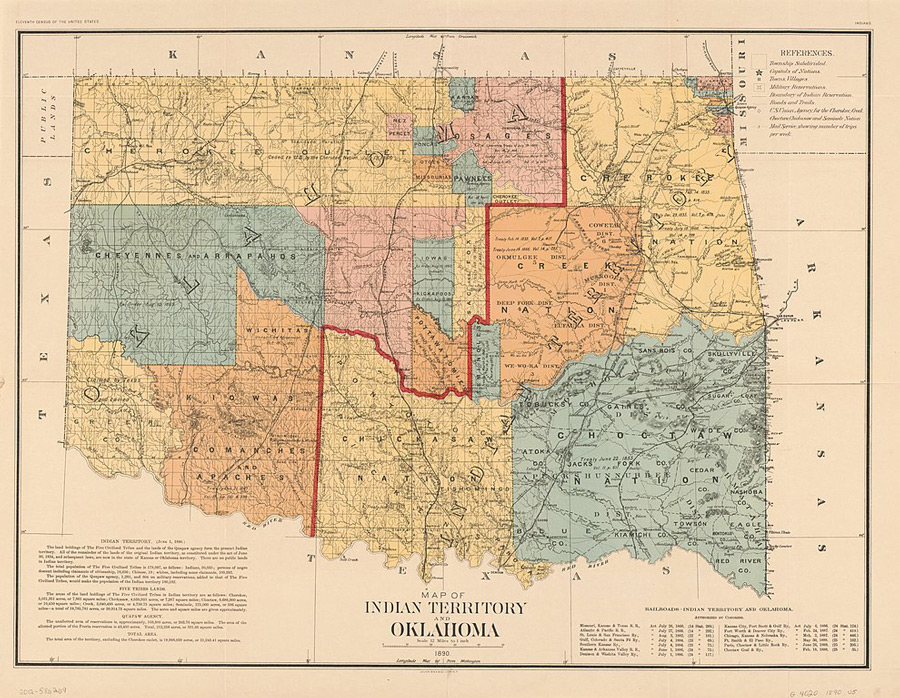
In the long-term, of course, this had a great importance for Tulsa. If the State of Sequoyah had been created, Tulsa would have become its dominant urban center. At the time of statehood Muskogee was bigger than Tulsa and probably would have become the capital city of the new state. Muskogee was where the Constitutional Convention for the State of Sequoyah was held in 1905. Over time, of course, the oil boom in the Tulsa region would have placed us in a position of political and economic leadership in the State of Sequoyah, instead of the alienated relationship that we have had with the capital(s) of the State of Oklahoma. The relationship of Tulsa and state government would have been dramatically different in the State of Sequoyah, and this likely would have had a profound effect on Tulsa's cultural development.
It was not only the politics of party balance in Washington that affected Congress's decision to block the creation of the State of Sequoyah. Racism against native peoples also undoubtedly played a role. Turning "Indian Territory" into the "State of Sequoyah" would have created a state with a a large population of Native Americans. Maybe the people of the State of Sequoyah would have even elected Native Americans to represent them in the all-male, all-White United States Senate! It was much safer for the power establishment at the Capitol to combine Oklahoma Territory and Indian Territory into a single state, thus diluting the impact of Native American voters and guaranteeing a clear White majority among the new state's electorate.
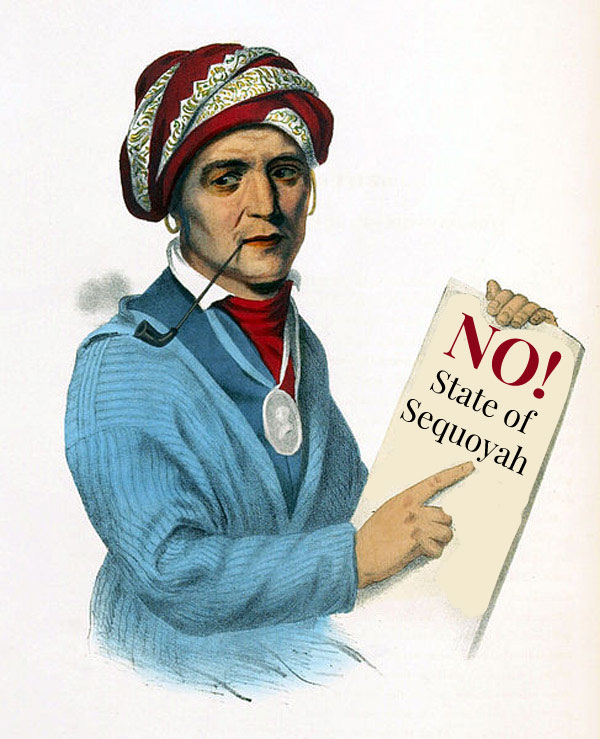
Ten states in our country are named after historical people. Eight of these states are named after Europeans who never once set foot in North America, and one is named after a European immigrant. Only one state, the State of Washington, is named after a person born in North America. The State of Sequoyah would have been the second. And it would have been the only state carrying the name of a Native American. The scoreboard: Europeans 8, Native Americans 0.
The winners write the history books, we are reminded, and this has certainly happened in the case of the State of Oklahoma. Many things that predated the forced merger of the two territories are now taught as "Oklahoma" history. We read about our "Oklahoma territorial governors", for example ...but Indian Territory never had territorial governors. That only happened over in Oklahoma Territory. There were no land runs in Indian Territory. And in the case of the many settlers who slipped across the borders of the land run lands early and entered illegally (the so-called "sooners"), they were Oklahoma Territory people, not Indian Territory people. (We should note that today Oklahomans celebrate those law-breaking "sooners" even as they point with disapproval at the latter day undocumented immigrants arriving in our state.)
Settlement patterns in Indian Territory and Oklahoma Territory were different, but in both cases settlers brought their politics with them. In the northern part of the state, settlers heavily came from the North and brought Republican politics. In the southern part of the state, settlers came heavily from the South and brought Democratic politics. In recent decades Oklahoma politics has shifted, but for more than half of Oklahoma history the voting map of the state was divided along the middle between Democrats and Republicans.
Oklahoma was born in the politics of Washington D.C., but it was also born into the politics of American populism. Oklahoma of the statehood era was primarily rural, populated by small farmers and the town communities that served them. Our populism was rural and grew out of the hostility of farmers against the big economic interests that held power over them, especially the railroads. This hostility extended against Eastern bankers and all those that were felt to take advantage of the economic powerlessness of Oklahoma's rural populations.
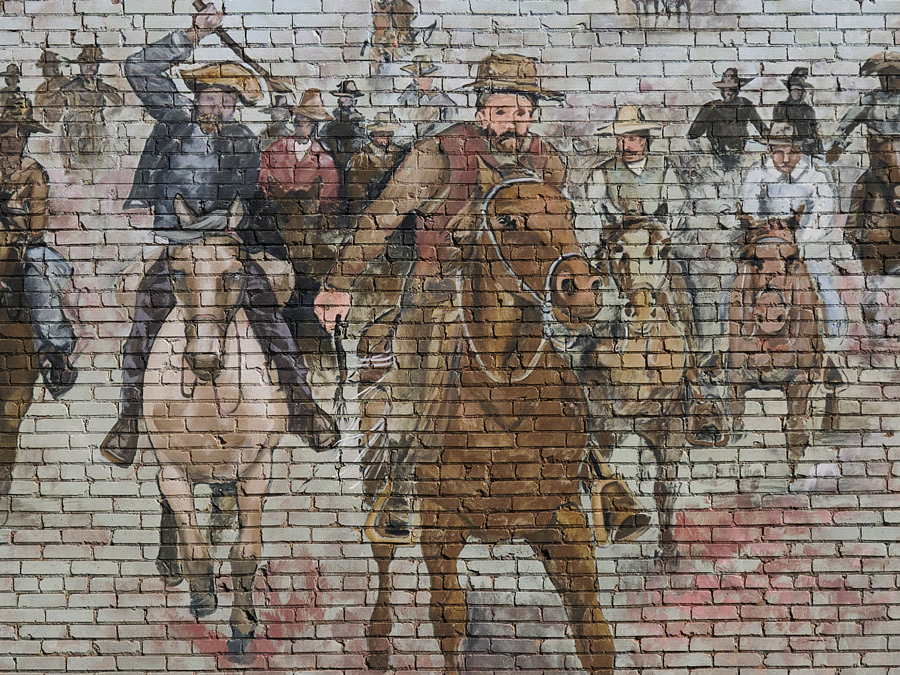
We see this populism expressed very neatly in our state's constitution, the longest in the nation. The populist controlled majority that wrote the constitution feared that the interests of big money would dominate state politics and that the best protection against the mischief of these powerful forces was to write as many protections as possible in the constitution itself. Our constitution, for example, specifies the flash point for kerosene (widely used on farms). It also provided for one of the longest lists in the country of state officials to be directly elected at the ballot box. This was changed in the 1970's, but the provision was originally enacted to guarantee to citizens the right to pick the people who would regulate their interests rather than leaving these important posts to gubernatorial appointment, appointments that might be made by governors under the influence of the railroads and the bankers. The constitution also provided that changes to the constitution could only happen by a vote of the people themselves, thus insulating the protections contained in it from shady maneuvers at the State Capitol.
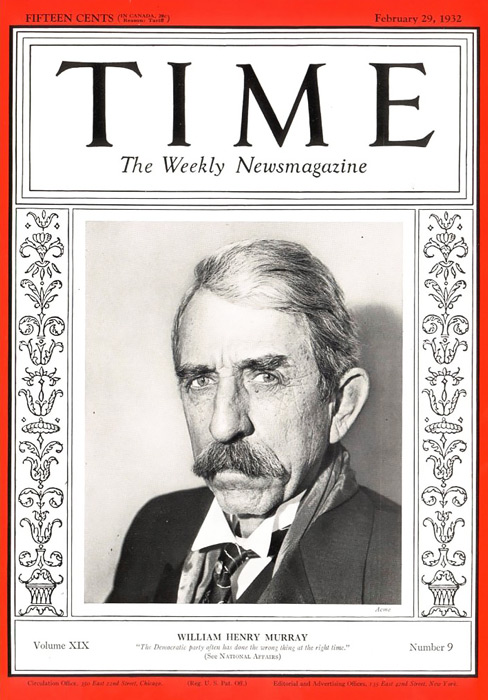
Alfalfa Bill Murray, perhaps our state's most colorful political figures, was the only Oklahoman ever to appear on the cover of Time magazine while a resident of the state.
Oklahoma used to be thought of as a state dominated by Democrats, and indeed Democrats controlled state offices and held an overwhelming majority in the legislature up until relatively recently. Republicans, however, constituted a significant minority and occasionally won secondary offices or a U.S. Senate seat. Races were sometimes competitive, but Democrats almost always emerged as the winners.
We can look back at the presidential election of 1952 as marking the beginning of Oklahoma’s shift to the Republican Party. In that year the Republican candidate, Dwight Eisenhower, received about the same percentage of the vote in Oklahoma as he received nationwide. This repeated in 1956. In 1960 the Democrats nominated John Kennedy, a Roman Catholic, and there was strong rejection of his candidacy by Oklahoma Protestants. His percentage of the vote in Oklahoma was far behind what he received nationwide.
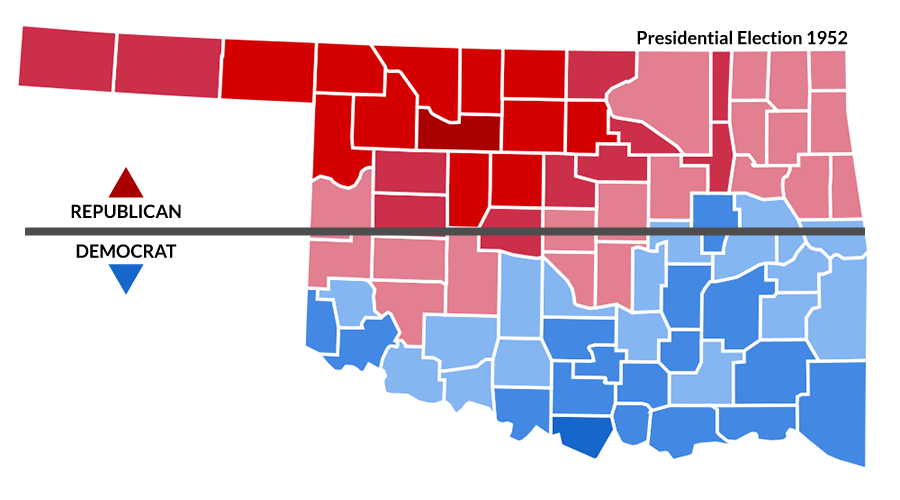
In every presidential election since 1960 the Democratic candidate has run behind the party's national results, often significantly and sometimes dramatically. In time, the shift that began at the presidential election level began to began to be reflected in state and local races.
In 1962 Oklahoma elected a Republican as governor for the first time in the state's history. Today, of course, Republicans consistently win statewide elections and control the state legislature with a majority that equals what Democrats at one time enjoyed.
Tulsa, with many of its important leaders having come from Eastern states, was a strong base of support for the Republican Party in Oklahoma. In this sense, Tulsa shared the political origins of other northern Oklahoma counties. Because of Tulsa's economic importance and population size, its influence in the Republican Party remained highly significant in the state until well into the second half of Oklahoma history. Up until the 1970s or 80s, Tulsa was the “capital city” of the Oklahoma Republican Party. It was the capital city in the sense of being the largest and most important center of Republicanism in Oklahoma, and it was also the “capital” of the party in the sense that it was the place from which most of the party's funding came. Tulsa's role diluted as more Oklahomans switched to the Republican Party. The Republicanism of Tulsa was influenced by leaders whose roots were in northeastern American economic conservatism and old-fashioned “good government” values. As the party expanded and grew in Oklahoma, however, Tulsa’s influence declined and new registrants in the party tended to prioritize social conservatism.
Oklahoma’s transition from being a Democratic state to a Republican one is not altogether surprising. Oklahoma Democrats, mostly Southern in origin, tended to be conservative like Democrats in southern states. The white southern migration to the Republican Party following the civil rights legislation of the 1960s was mirrored in Oklahoma. Northern Oklahoma already had a strong Republican tradition, and the addition of the new adherents exiting the Democratic Party produced a solid Republican party majority in the state. Sen. Robert Kerr, a Democrat and former governor, was a powerful force in Oklahoma politics for many years. He was a conservative like most Democrats from the South (though orig. He was a very perceptive observer of Oklahoma political trends, and he predicted this political shift before his death on January 1, 1964.
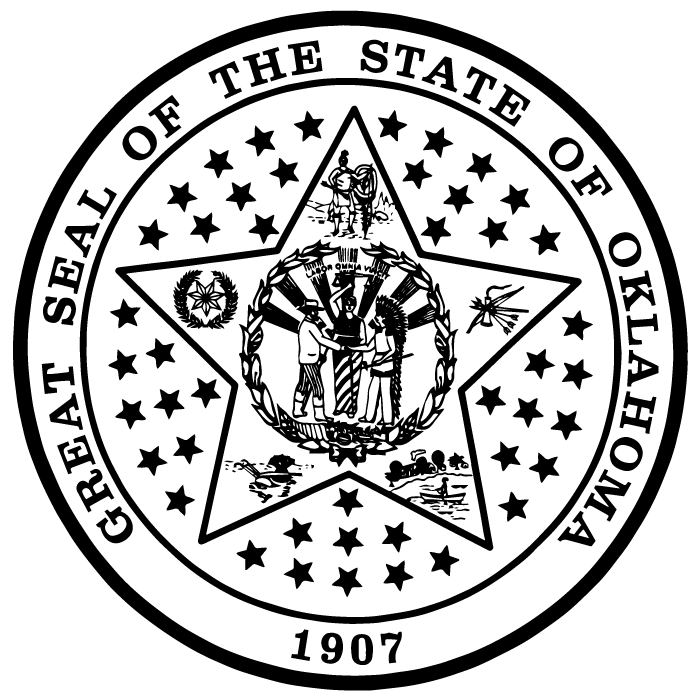
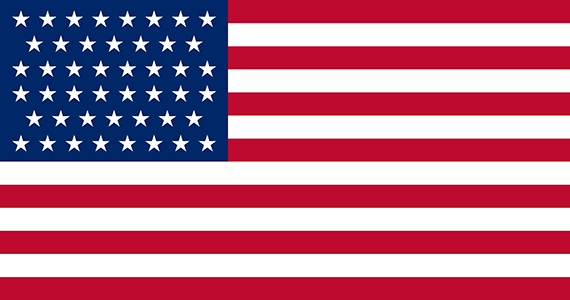
For the first half of our history, Oklahoma had a rural dominated state government. Up until intervention by the federal courts in the 1960s, the Oklahoma House and Senate reapportioned themselves after each decennial federal census in accordance with what they thought best, without any regard to equality of population in the districts that they drew. For many decades Tulsa was given seven members of the Oklahoma House, out of a total of 124 members. The Senate had forty-four members and Tulsa was allowed to have one of them. Oklahoma County was also limited to one member of the Senate. At the time of court mandated reapportionment, Tulsa and Oklahoma counties had 30% the states population between them but only 5% of the representation in the Oklahoma Legislature. Some of the rural districts had population that were quite small, but the country legislators who drew the legislative maps had no desire to cede power to the big cities. Gross inequality in the sizes of legislative districts continued until the 1960's when federal courts adopted the principle of “one man, one vote”. This resulted in the forced re-drawing of legislative districts based upon the principle of equality of population.
The reapportionment of the legislature caused a seismic shift in power at the Capitol, though rural influences still tended to be very strong. This was true partly because of the influence of some of the longtime legislators, but also for the obvious reason that a majority of the state at the time of reapportionment was still non-urban. Nevertheless, the two cities started making gains as a result of their increased legislative influence. This was most visible in terms of state-supported higher education: junior colleges offering professional courses and the first two academic years towards a bachelor’s degree were created in Tulsa and Oklahoma City. The new big city legislators also sought to insure a fairer distribution of state expenditures between the cities and the rural counties.
The increased urban representation at the Capitol was somewhat diluted in its political impact, however, because the city legislative delegations were politically divided between the two parties. As legislative power works in Oklahoma, real influence on public policy lies inside the caucus of the party with the majority of legislative members. Democrat and Republican votes are of equal weight on the floors of the House and Senate, but legislative policy is effectively decided inside the closed door meetings of majority party caucuses.
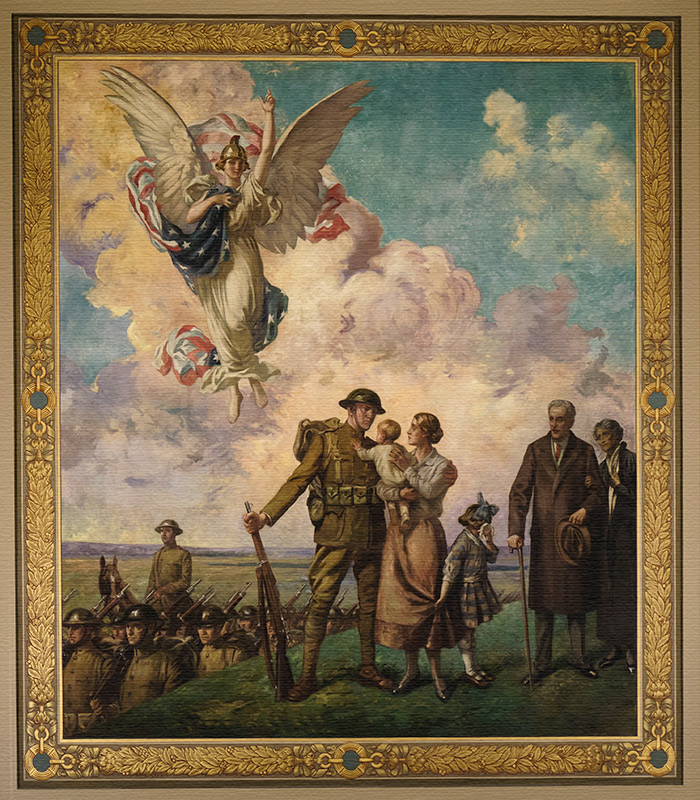
Oklahoma’s Constitution created one of the weakest executive branches of state government in the nation. This was a reflection of the populist influence in the Constitutional Convention. The populists feared concentrated executive power that could be corrupted by big economic interests. The weakness of the governor in the Oklahoma system was further exacerbated by two developments that began in the 1930's and 1940’s. One was the creation of the Oklahoma Public Welfare Commission during the Depression era. The Commission was given earmarked sales tax funding that did not require legislative appropriation (or oversight). Its director for over 30 years was one of the towering and historic figures in Oklahoma government, L. E. Rader. The welfare operations of the state extended into every county, and and the department ran institutions scattered across the state. Each county welfare office, and each institution, offered opportunities for political patronage in the home districts of Oklahoma legislators. They also gave Rader the ability to extend other kinds of useful favors, and he was a gifted and skilled manipulator of the powers available to him. Many of the legislative leaders (and governors) answered to Mr. Rader, rather than him answering to the them. Rader accumulated exceptional power and he knew how to use it.
Another long-time power was E. T. Dunlap, for two decades the Chancellor of the Oklahoma State System of Higher Education. The Oklahoma State System of Higher Education was a constitutional creation dating from the 1940’s, and it guaranteed colleges and universities independence from political influence. This amendment created a higher education system governed by a nine person constitutional board, the State Regents for Higher Education. Under this constitutional system, the Oklahoma legislature makes a single lump sum appropriation to the State Regents and the they are the ones who decide how to distribute it, not the legislators. At the time of the creation of the system, Oklahoma governors were not allowed to succeed themselves, and therefore the number nine was significant because it meant that no single governor could ever appoint a majority of the members of the regents.
For many decades the Welfare Commission and the State Regents for Higher Education between them received over half of state expenditures, but with very limited oversight by Oklahoma elected officials. Both Rader and Dunlap liked it that way, of course, and they were clever and creative in keeping prying legislators at bay. When troublesome requests for information were submitted to Mr. Rader, he would reply by sending cardboard boxes full of computer printouts and copies of records. The legislators, who had very limited staff, lacked the ability to comb through all the stacks of information that they received, but they also could not complain that Rader had not been responsive. The legislators would simply shrug their shoulders and move on to some other topic. Chancellor E. T. Dunlap, on the other hand, was a talker. You always wanted to be careful what you asked him, otherwise his answer would begin with a detailed explanation of the history of the process by which the constitutional amendment creating the State System of Higher Education was adopted in the 1940’s and then he would continue by explaining in detail every change made through the years up until he got to the point in history that contained the answer to the question you had asked. All of this could take an exhaustive among of time. As one legislative wit (who later became president of a small college) described it, “The job of the Chancellor is to come to legislative committee meetings and to talk until there isn’t time for questions.”
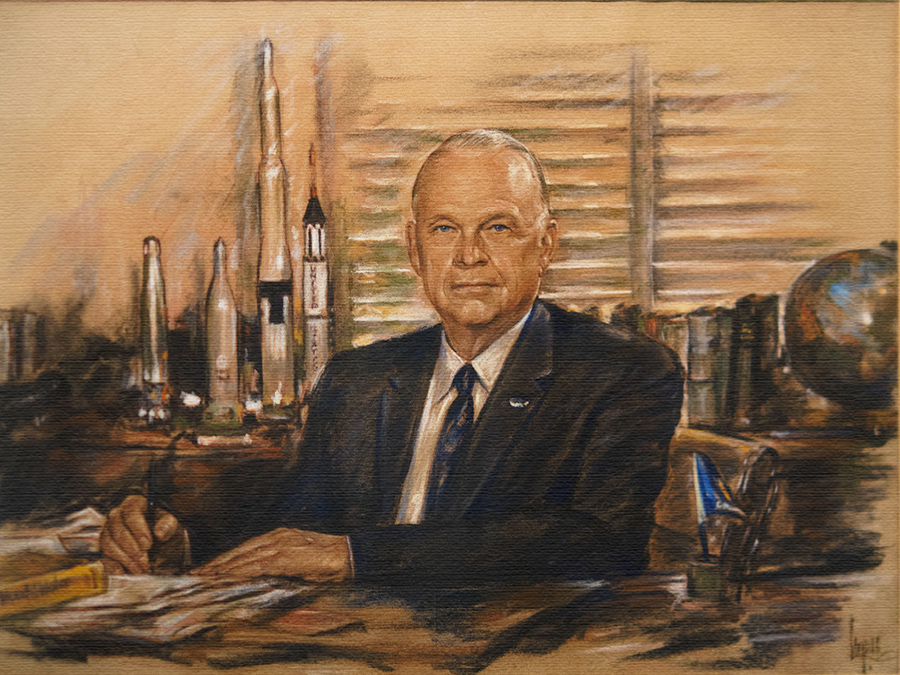
Robert S. Kerr is an interesting example of political leaders in earlier Oklahoma, though he was certainly one of the most exceptional, and successful, of them. In many ways he mirrored the economic and cultural evolution of Oklahoma. He was born in humble circumstances but achieved wealth in the oil business. He began in politics as a supporter of Franklin D. Roosevelt's New Deal and ended up a conservative. Once he entered politics after first having built his business interests, his rise was rapid. He gained early national attention when he was selected by President Roosevelt as keynote speaker at the Democratic national convention in 1944, just two years after his election as Governor (his first public office). The New York Times's coverage of the speech praised his oratorical skills, saying the speech was delivered from "the eloquent lips of Gov. Kerr." He was elected to the Senate in 1948, and reelected twice after that. In Washington he gained a reputation as a talented dealmaker and became known as the "uncrowned king" of the Senate. "I'm opposed to any combine that I'm not in on," was one of his sayings. His wheeling and dealing in Washington was very beneficial for Oklahoma, of course. He is responsible for the Kerr-McClellan Arkansas River Navigation System that resulted in Tulsa becoming a port city, connected by water to New Orleans. The navigation system is just one example of his impacts on Oklahoma. Another important legacy is the Kerr Foundation in Oklahoma City, now headed by Lou Kerr, which is heavily involved in supporting educational activities.
One of the distinguishing characteristics of Oklahoma is that it is made up of six distinct cultural regions. It’s typical for states to have more than one identifiable cultural region (think of t Louisiana with its southern Catholic French region and its northern Protestant region or New York State with its upstate and downstate regions). Every state has multiple geographic distinctions ...but what is significant in Oklahoma, and different from most other states, is that we have six distinct cultural regions despite our relatively small population.
If we divide the state in half between the North and the South, we have two regions based on the settlement of the North by people from the northern part of the United States, and the South settled by people from southern states. That gives us two regions, but the eastern and western halves of these sections of the state are geographically and economically different. The North and South of Oklahoma may have originally been settled by pioneers who shared much in common, but, as people adapted to the nature of the land and and the economic possibilities of each region, natural adjustments evolved over time in cultural values and norms. This, then, gives us four cultural regions: the northern and southern halves of the eastern and western halves of the state.
Then we add Tulsa and Oklahoma City as additional cultural regions, both distinct from each other at the same time they are distinctly different from the rural parts of the state. Tulsa has a strong eastern American cultural influence. Oklahoma City, on the other hand, is representative of “western” American culture. We are a state with two major cities, each separated by 100 miles of highway and 1000 miles of cultural differences.
The two urban cultural areas plus the four non-urban ones gives us a total of six cultural regions that make up Oklahoma. The existence of six separate regions ...regions with conflicting priorities and values, all inside a state that is not heavily populated... has always undermined our state's ability to develop coherent and sustained public policies. In Oklahoma, "coming together" has always been difficult. It is likely to remain so. From one cultural region to another in Oklahoma the channels of communication between leadership groups are usually weak. This means that the leaders that influence public policy choices through their influence on public opinion (and through their relationships with elected officials) don't talk to each other as they should and don't even understand each other as they should. Without these leaders coming together to create state-wide consensuses on issues, it is difficult for real public policy progress to be made in Oklahoma.
(P.S. Organizations that work towards building communication bridges, like the Oklahoma Academy, do exist and are critically important, but they need broader and deeper support.)
 Prof. Rodger A. Randle
Prof. Rodger A. Randle